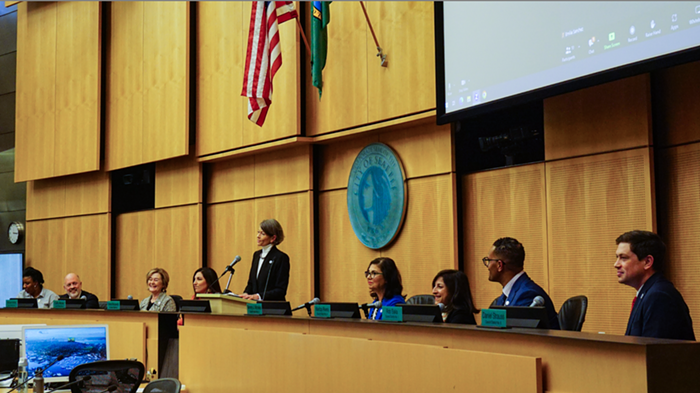
On Tuesday afternoon, Mayor Bruce Harrell revealed the latest element of his plan to end homelessness in Seattle: a dashboard. Now, any pearl-clutching Laurelhurst resident can click around the new “One Seattle Homeless Action Plan” dashboard and track the City’s shelter capacity, shelter offers, the locations of past encampment sweeps, and how much money both the City and the King County Regional Homelessness Authority (KCRHA) are spending to make it all happen.
In classic Harrell fashion, he said that the Tuesday press conference introducing the new tool did not serve as a victory lap but rather a “victory step.” As a self-described “data-guy,” Harrell said the first step to solving the homelessness crisis was to quantify it.
“Even if we run the risk of looking at the soft underbelly of a city, we have to look at the data so that we can track our progress,” he said at the press conference.
But the Tech Bros (not derogatory) over at Tech 4 Housing said that after seven years of an official homelessness crisis in Seattle, the last thing we need is another dashboard.
Calvin Jones, who organizes with Tech 4 Housing, a housing advocacy group of tech workers, agreed that the City probably needs to quantify problems in order “to shepherd the organizational resources” to solve those problems. However, he said the information on the Mayor's dashboard is old news repackaged in a new way.
Even Harrell said that other entities have organized similar data. For example, the KCRHA already keeps a tally of available shelter beds, and the HOPE team reports the number of shelter referrals it makes quarterly. Still, Harrell said that he sees value in getting all the data (and the agencies that handle homelessness) on the same page – in a literal and figurative sense.
But Jones cautioned that dashboards present an opportunity for governments to spin the numbers.
“There’s this myth that if you have more data, you’ll be better for it, but data is not objective. Data always comes with a point-of-view,” Jones said.
According to Jones, the City’s dashboard organized its data with a very clear point-of-view: Homelessness is a problem for the people seeing it rather than for those experiencing it.
A dashboard is supposed to track progress toward a solution. With the new homelessness dashboard, the tab that displays a map of encampments the city has swept communicates that sweeps are “progress,” which implies that the solution to homelessness is putting it out of sight, Jones said.
A more housing-first framework for this type of dashboard would set the end goal to zero homelessness, he argued. For instance, the dashboard could show the number of Seattle residents who do not have housing next to the number of different shelter and housing options the City would need to accommodate those residents. That way, progress is not sweeps, or “identifying” shelter beds, or making referrals, but rather working both of those numbers down to zero.
“Public agencies don't make dashboards like that because they don't have the resources to actually get to zero homelessness. Everyone's twisting themselves in knots to frame the problem to show how their current strategy is helping. Even if it's not,” Jones said.
Even a dashboard that does not frame sweeps as the solution would not serve as a “victory step” towards solving homelessness. That’s because, as academics and advocates have argued over and over again, the solution to homelessness is not dashboards. It’s housing. How many dashboards does it take to build a house? “I’ll have to ask a software engineer,” Jones said.
Suresh Chanmugam, another organizer with Tech 4 Housing, said the real issue is that “every mayor builds a new dashboard instead of just requiring wealthy tech execs to pay their fair share in local taxes.”
“Despite the name [“One Seattle Homeless Action Plan”], we actually have two Seattles,” he continued in a text. “Our city has the most regressive tax system in the country. If Amazon CEO Andy Jassy (who lives on Capitol Hill) paid the same local tax rate as an Amazon Prime Delivery Driver, our city could fund a hotel room and a 24/7 social worker team TONIGHT for each and every person who is unsheltered."



















